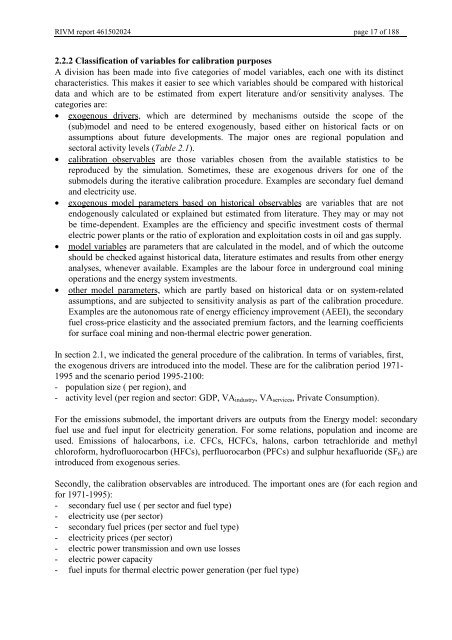Targets IMage Energy Regional (TIMER) Model, Technical ...
Targets IMage Energy Regional (TIMER) Model, Technical ...
Targets IMage Energy Regional (TIMER) Model, Technical ...
You also want an ePaper? Increase the reach of your titles
YUMPU automatically turns print PDFs into web optimized ePapers that Google loves.
RIVM report 461502024 page 17 of 188<br />
&ODVVLILFDWLRQRIYDULDEOHVIRUFDOLEUDWLRQSXUSRVHV<br />
A division has been made into five categories of model variables, each one with its distinct<br />
characteristics. This makes it easier to see which variables should be compared with historical<br />
data and which are to be estimated from expert literature and/or sensitivity analyses. The<br />
categories are:<br />
• exogenous drivers, which are determined by mechanisms outside the scope of the<br />
(sub)model and need to be entered exogenously, based either on historical facts or on<br />
assumptions about future developments. The major ones are regional population and<br />
sectoral activity levels (7DEOH).<br />
• calibration observables are those variables chosen from the available statistics to be<br />
reproduced by the simulation. Sometimes, these are exogenous drivers for one of the<br />
submodels during the iterative calibration procedure. Examples are secondary fuel demand<br />
and electricity use.<br />
• exogenous model parameters based on historical observables are variables that are not<br />
endogenously calculated or explained but estimated from literature. They may or may not<br />
be time-dependent. Examples are the efficiency and specific investment costs of thermal<br />
electric power plants or the ratio of exploration and exploitation costs in oil and gas supply.<br />
• model variables are parameters that are calculated in the model, and of which the outcome<br />
should be checked against historical data, literature estimates and results from other energy<br />
analyses, whenever available. Examples are the labour force in underground coal mining<br />
operations and the energy system investments.<br />
• other model parameters, which are partly based on historical data or on system-related<br />
assumptions, and are subjected to sensitivity analysis as part of the calibration procedure.<br />
Examples are the autonomous rate of energy efficiency improvement (AEEI), the secondary<br />
fuel cross-price elasticity and the associated premium factors, and the learning coefficients<br />
for surface coal mining and non-thermal electric power generation.<br />
In section 2.1, we indicated the general procedure of the calibration. In terms of variables, first,<br />
the exogenous drivers are introduced into the model. These are for the calibration period 1971-<br />
1995 and the scenario period 1995-2100:<br />
population size ( per region), and<br />
activity level (per region and sector: GDP, VA industry , VA services , Private Consumption).<br />
For the emissions submodel, the important drivers are outputs from the <strong>Energy</strong> model: secondary<br />
fuel use and fuel input for electricity generation. For some relations, population and income are<br />
used. Emissions of halocarbons, i.e. CFCs, HCFCs, halons, carbon tetrachloride and methyl<br />
chloroform, hydrofluorocarbon (HFCs), perfluorocarbon (PFCs) and sulphur hexafluoride (SF 6 ) are<br />
introduced from exogenous series.<br />
Secondly, the calibration observables are introduced. The important ones are (for each region and<br />
for 1971-1995):<br />
- secondary fuel use ( per sector and fuel type)<br />
- electricity use (per sector)<br />
- secondary fuel prices (per sector and fuel type)<br />
- electricity prices (per sector)<br />
- electric power transmission and own use losses<br />
- electric power capacity<br />
- fuel inputs for thermal electric power generation (per fuel type)
















